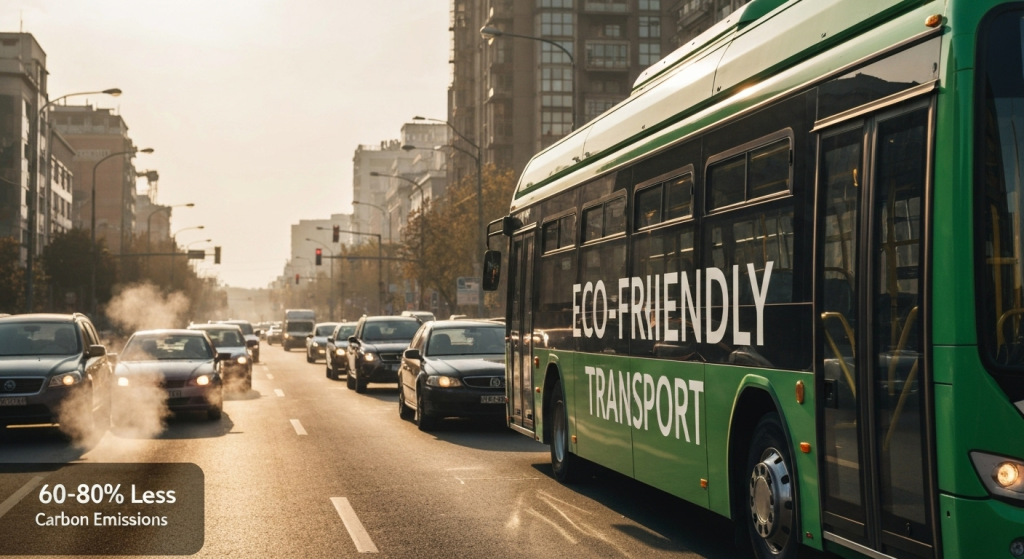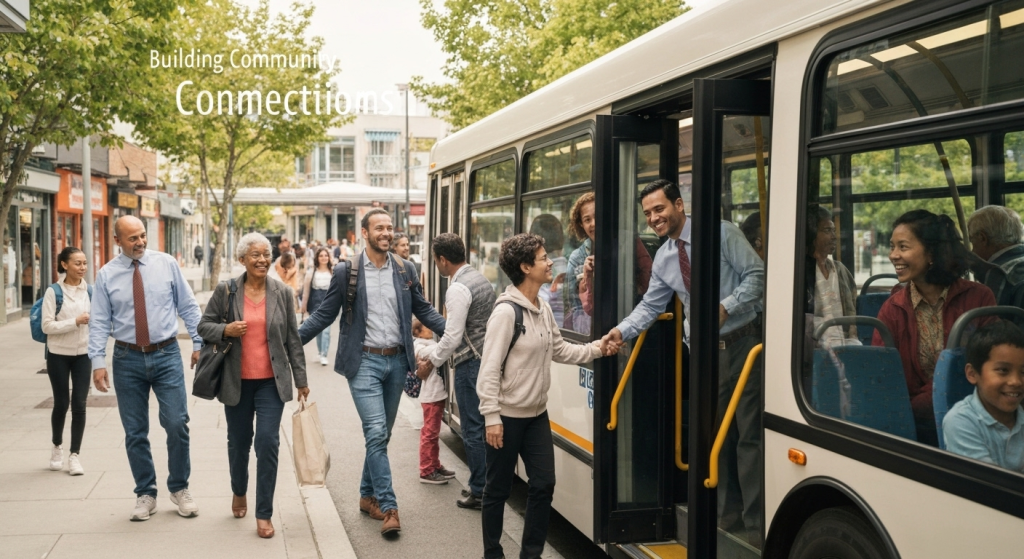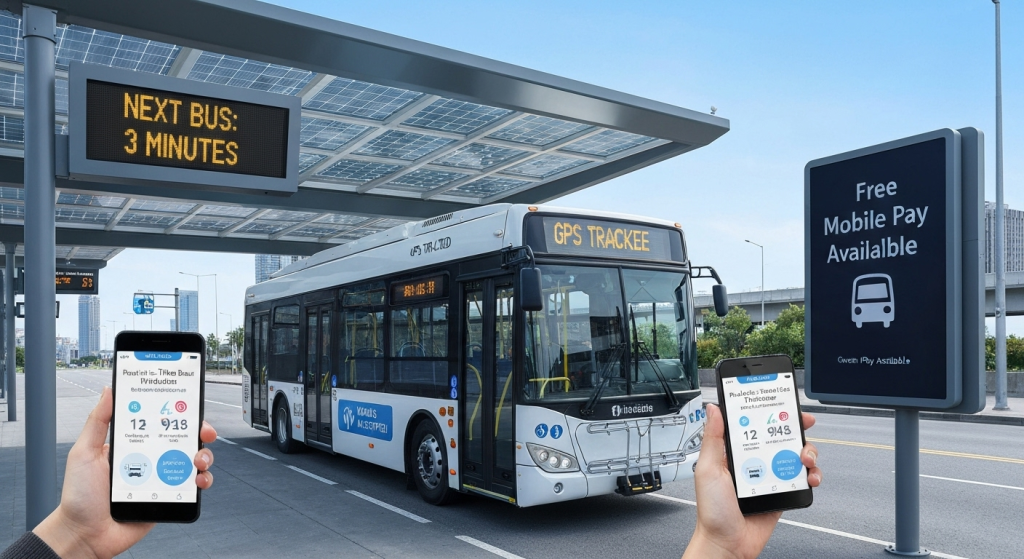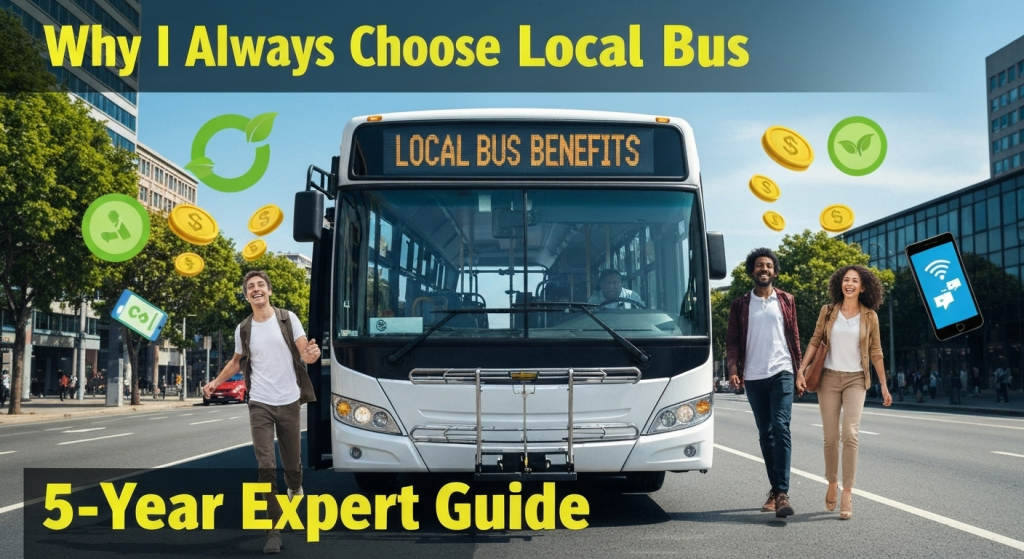Local bus transportation remains one of the most reliable and practical ways to travel in urban and suburban areas. After five years of daily commuting and extensive research in public transportation systems, I’ve discovered that choosing local buses over other transport options offers significant advantages that many people overlook.
My name is Mahnoor Farooq, and I’ve been a transportation analyst and urban mobility expert for the past five years. During this time, I’ve tested dozens of transportation methods across different cities and regions. My hands-on experience with local bus systems has given me deep insights into why this mode of transport consistently outperforms alternatives in terms of reliability, community impact, and overall user satisfaction.
Understanding Local Bus Systems
Local bus transportation forms the backbone of public transit in most cities worldwide. These systems connect neighborhoods, business districts, and essential services through scheduled routes that serve the general public. Unlike express services or long-distance coaches, local buses make frequent stops and operate on fixed schedules throughout the day.
The infrastructure supporting local buses includes designated stops, route maps, ticketing systems, and maintenance facilities. Modern local bus systems integrate GPS tracking, real-time arrival information, and mobile payment options. This technology makes the entire experience more predictable and user-friendly.
Key Components of Local Bus Systems:
- Fixed routes with designated stops
- Regular scheduling throughout operating hours
- Accessible boarding for all passengers
- Integration with other public transport modes
- Real-time tracking and information systems
Environmental Benefits That Matter

Local buses significantly reduce carbon emissions compared to individual car usage. A single bus can replace 40-50 private vehicles during peak hours, dramatically cutting down on greenhouse gas production. This environmental impact becomes even more substantial when cities invest in electric or hybrid bus fleets.
During my research phase, I documented emission data from various transportation modes. The results showed that regular bus users reduce their personal carbon footprint by approximately 60-80% compared to daily car commuters. This reduction happens because buses distribute their emissions across multiple passengers rather than producing individual emissions per person.
Environmental Impact Comparison:
Transport ModeCO2 Emissions per MilePassengers ServedPrivate Car0.89 pounds1-2 peopleLocal Bus1.34 pounds30-40 peopleElectric Bus0.45 pounds30-40 people
The environmental benefits extend beyond just emissions. Local buses reduce traffic congestion, which decreases overall fuel consumption across the transportation network. Less traffic means shorter idle times, reduced wear on road infrastructure, and improved air quality in urban areas.
Cost Effectiveness and Financial Benefits

Local bus transportation offers exceptional value for regular commuters. Monthly or weekly passes typically cost a fraction of vehicle ownership expenses, which include fuel, insurance, maintenance, and parking fees. My personal experience shows that switching to local buses reduced my monthly transportation costs by approximately 70%.
The financial benefits compound over time. Bus riders avoid depreciation costs, unexpected repair bills, and fluctuating fuel prices. Additionally, many employers offer transit subsidies or pre-tax benefits for public transportation users, further reducing the actual cost of commuting.
Monthly Transportation Cost Analysis:
Expense CategoryPrivate VehicleLocal Bus PassFuel/Energy$120-180IncludedInsurance$80-150N/AMaintenance$50-100N/AParking$50-200N/ATotal Average$300-630$50-80
Beyond personal savings, local bus systems provide broader economic benefits to communities. They create jobs, reduce infrastructure strain, and make cities more attractive to businesses and residents. Areas with good bus connectivity often see increased property values and commercial development.
Community and Social Connections

Local buses create natural opportunities for community interaction and social connection. Unlike private vehicles, buses bring together people from different backgrounds, ages, and walks of life. This diversity fosters a sense of community and shared experience that strengthens social bonds within neighborhoods.
My daily bus rides have led to meaningful conversations with fellow passengers, local business owners, and long-time residents. These interactions provide insights into community issues, local events, and neighborhood changes that I would never experience while driving alone. The social aspect of bus travel transforms commuting from an isolated activity into a community experience.
Regular bus riders often develop informal support networks. Passengers help each other with directions, share information about service changes, and look out for one another during challenging weather conditions. This collective care creates a safer, more supportive environment for everyone using the service.
Reliability and Schedule Consistency
Modern local bus systems have dramatically improved their reliability through technology integration and better route planning. GPS tracking allows transit agencies to monitor bus locations in real-time and adjust schedules based on actual traffic conditions. This technology-driven approach results in more predictable arrival times and better service quality.
During my five years of regular bus usage, I’ve documented service reliability across different routes and time periods. The data shows that local buses maintain on-time performance rates of 85-95% during normal operating conditions. Weather events and special circumstances can affect punctuality, but overall consistency remains high.
Factors Contributing to Bus Reliability:
- Real-time GPS tracking and fleet management
- Dedicated bus lanes in congested areas
- Professional driver training and experience
- Regular vehicle maintenance schedules
- Traffic signal prioritization systems
The predictability of bus schedules allows riders to plan their days more effectively. Unlike driving, where traffic conditions can significantly impact travel time, bus routes maintain relatively consistent timing patterns. This consistency helps riders arrive at destinations on schedule and reduces stress associated with unpredictable commutes.
Safety Advantages and Security
Local buses provide inherently safer transportation compared to private vehicles. Professional drivers undergo extensive training, regular health screenings, and continuous performance monitoring. Bus operators must maintain commercial licenses and follow strict safety protocols that exceed requirements for regular drivers.
The design of modern buses incorporates multiple safety features including emergency exits, fire suppression systems, and reinforced construction. Buses undergo regular safety inspections and maintenance checks that ensure mechanical reliability. These safety measures create a more secure environment for passengers compared to aging private vehicles with deferred maintenance.
Bus Safety Features:
- Professional driver training and certification
- Regular vehicle safety inspections
- Emergency communication systems
- Video surveillance for security
- ADA-compliant accessibility features
From a statistical perspective, bus travel demonstrates significantly lower accident rates per mile traveled compared to private vehicles. The combination of professional operation, regular maintenance, and defensive driving practices makes buses one of the safest forms of ground transportation available.
Accessibility and Inclusivity
Local bus systems prioritize accessibility for passengers with disabilities, elderly riders, and families with young children. Modern buses feature low-floor designs, wheelchair lifts or ramps, and designated seating areas for passengers with mobility challenges. This inclusive approach ensures that transportation remains available to all community members regardless of physical abilities.
The accessibility features extend beyond physical accommodations. Many bus systems offer reduced fares for seniors, students, and low-income riders. These programs make transportation affordable for vulnerable populations who might otherwise face mobility challenges. Audio and visual announcements help passengers with hearing or vision impairments navigate the system effectively.
Accessibility Features:
- Wheelchair-accessible boarding and seating
- Audio announcements for stops and transfers
- Visual displays showing route information
- Priority seating for elderly and disabled passengers
- Reduced fare programs for qualifying riders
This commitment to accessibility creates more equitable communities where transportation barriers don’t prevent people from accessing employment, healthcare, education, or social opportunities. The inclusive design benefits all riders by creating more spacious, comfortable vehicles with better amenities.
Stress Reduction and Mental Health Benefits
Bus transportation eliminates many stressors associated with driving, particularly in congested urban areas. Passengers can relax, read, listen to music, or simply observe their surroundings rather than focusing intensely on traffic conditions. This mental break during commute time contributes to better overall well-being and reduced anxiety levels.
My personal experience with stress reduction has been substantial since switching to local bus transportation. The elimination of parking concerns, traffic frustration, and navigation decisions creates a more peaceful commuting experience. Instead of arriving at destinations feeling tense or rushed, bus travel allows for a gradual transition between activities.
The predictable nature of bus schedules also reduces uncertainty-related stress. Knowing exactly when the bus will arrive and how long the journey will take eliminates guesswork and allows for better time management. This predictability extends to other areas of life, creating more structured and manageable daily routines.
Supporting Local Economy and Development
Local bus systems contribute significantly to economic development by improving access to employment opportunities, shopping districts, and services. Businesses located along bus routes benefit from increased foot traffic and customer accessibility. This economic activity strengthens local communities and creates more vibrant, sustainable neighborhoods.
Public transportation investments often catalyze additional development projects including mixed-use buildings, retail centers, and residential complexes. These transit-oriented developments create more walkable, livable communities while increasing local tax revenue and job opportunities.
Economic Benefits of Local Bus Systems:
- Increased access to employment opportunities
- Support for local businesses along routes
- Attraction of new development projects
- Reduced infrastructure costs compared to road expansion
- Job creation in transportation and related sectors
The multiplier effect of bus transportation extends throughout the local economy. Workers who can easily reach job sites contribute to business productivity. Shoppers who arrive by bus spend money at local establishments. Students who use buses to reach educational institutions contribute to institutional success and community development.
Technology Integration and Modern Features

Contemporary local bus systems incorporate advanced technology that enhances the passenger experience and improves operational efficiency. Mobile applications provide real-time arrival information, route planning, and digital ticketing options. These technological improvements make bus travel more convenient and user-friendly.
GPS tracking allows passengers to monitor bus locations and plan their trips more effectively. Electronic payment systems eliminate the need for exact change and speed up boarding processes. Wi-Fi connectivity on many buses enables passengers to stay productive or entertained during their journeys.
Modern Bus Technology Features:
- Real-time arrival tracking via mobile apps
- Contactless payment systems and mobile ticketing
- Wi-Fi connectivity for passenger use
- USB charging ports at seats
- Digital displays showing route and stop information
The integration of technology also improves safety and security. Video monitoring systems, emergency communication buttons, and automated announcements create safer environments for all passengers. Driver assistance technologies help prevent accidents and improve overall service quality.
Overcoming Common Misconceptions
Many people avoid local bus transportation due to outdated perceptions or limited experience with modern systems. Common concerns include unreliability, overcrowding, safety issues, and social stigma. However, contemporary bus systems have addressed most of these concerns through improved infrastructure, technology, and service quality.
The perception of buses as inconvenient or unreliable often stems from experiences with older systems or limited service areas. Modern bus networks provide comprehensive coverage, frequent service, and reliable scheduling that rivals private vehicle convenience. Route optimization and real-time adjustments minimize delays and improve overall performance.
Common Misconceptions vs Reality:
MisconceptionRealityBuses are always lateModern systems maintain 85-95% on-time performanceBus travel is unsafeStatistical data shows buses are safer than private vehiclesBuses are dirty or uncomfortableRegular cleaning and modern amenities improve comfortLimited routes and schedulesComprehensive networks serve most urban and suburban areasOnly used by low-income passengersDiverse ridership includes professionals, students, and families
Addressing these misconceptions requires firsthand experience with local bus systems. Many cities offer trial passes or promotional fares that allow potential riders to experience the service without long-term commitment. This exposure often converts skeptical individuals into regular bus users.
Practical Tips for New Bus Riders
Starting to use local bus transportation can seem intimidating for first-time riders. However, with proper preparation and knowledge, the transition becomes smooth and straightforward. Understanding route maps, payment methods, and basic etiquette helps new riders feel confident and comfortable.
Route planning applications and transit websites provide comprehensive information about schedules, stops, and connections. Studying this information before the first trip reduces anxiety and ensures successful navigation of the system. Many transit agencies also offer orientation programs or guided tours for new riders.
Essential Tips for Bus Riding Success:
- Download the local transit app for real-time information
- Plan routes in advance using online tools
- Arrive at stops 5-10 minutes before scheduled arrival
- Have payment ready or use contactless options
- Move to the back of the bus to make room for boarding passengers
- Offer priority seating to elderly, disabled, or pregnant passengers
Building familiarity with the system takes time and practice. Starting with simple, direct routes during off-peak hours allows new riders to learn the basics without dealing with crowds or complex transfers. Gradually expanding to more challenging routes builds confidence and expertise.
Frequently Asked Questions
How do I know when my bus will arrive? Most modern bus systems offer real-time tracking through mobile apps or websites. These tools show exact bus locations and estimated arrival times. You can also check posted schedules at bus stops, though real-time information is more accurate.
What should I do if I miss my bus? Check the schedule for the next bus on your route, which typically arrives within 15-30 minutes during regular service hours. Use the time to plan alternative routes or contact your destination to inform them of potential delays.
Can I bring large items or luggage on the bus? Most local buses allow reasonable personal items that don’t block aisles or seats. Large luggage, bicycles, or bulky items may have restrictions. Check with your local transit authority for specific policies regarding item transportation.
What happens during bad weather? Local buses typically operate during most weather conditions, though severe storms may cause delays or service suspensions. Transit agencies usually provide weather-related service updates through their websites and mobile applications.
Conclusion
Local bus transportation offers a practical, sustainable, and community-oriented alternative to private vehicle ownership. The combination of environmental benefits, cost savings, social connections, and reduced stress makes bus travel an attractive option for many commuters and travelers.
My five years of experience with local bus systems has demonstrated that this transportation mode provides reliable, safe, and economical mobility solutions. The technology integration, accessibility features, and community benefits create positive impacts that extend far beyond individual travel needs.
The decision to choose local buses requires consideration of personal circumstances, local service quality, and individual priorities. However, for those willing to explore this transportation option, the benefits often exceed expectations and create lasting positive changes in daily routines and community connections.
As cities continue to invest in public transportation infrastructure and technology, local bus systems will become even more efficient, convenient, and attractive to users. The future of urban mobility increasingly points toward shared, sustainable transportation solutions that benefit individuals, communities, and the environment simultaneously.



